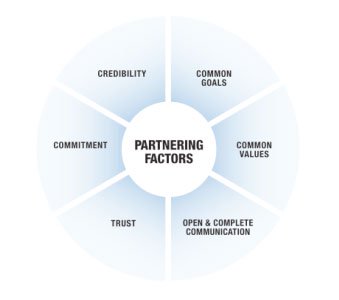Building Business Partnerships For Collaboration
Building group to group partnerships in government and business is more essential than ever. No group or person can do it alone. This article will answer three questions:
- What is driving the need for group to group partnerships?
- How do we characterize the heart of this challenge?
- What should be considered when building business partnerships?
 Business Drivers
Business Drivers
Here are some examples of common circumstances that drive the need for group partnership development and group collaboration.
Government Agencies
I recently served as a keynote speaker at a VA National HR Conference. I presented in the morning and John Kamensky from IBM presented at lunch. He spoke on the Six Trends Transforming Government. One of the six trends he talked about is “Using Networks and Partnerships.” His theme around this trend was “No one agency can deliver on anything important by itself.” To his point, the need to build effective partnerships across government agencies and leverage organizational teamwork was more than evident in the wake of Hurricane Katrina. Whether one looked at the cooperative success stories or the uncooperative horror stories, Katrina confirmed the need to build cross-agency partnerships.
Mergers and Acquisitions
Many, if not most of you, have experienced pain when two different companies “integrate” following a merger or acquisition. The two organizations often have very different cultures and ways of doing things, which can lead to an “us/them” divide that is difficult to bridge. All the while, the expected benefits of the acquisition are slow in coming and mediocre at best.
Vendors and Clients
As with mergers and acquisitions, vendor/client relationships can be fraught with cultural and team integration issues, especially around longer-term projects. If the divide is not bridged, the project has a high probability of failure.
Supply Chain
As supply chains become more complex and global, involving more players, relationships become more important. According to a recent Deloitte article, to be effective in supply chain management, companies must establish a “greater mutual understanding of the interests and challenges of all supply chain partners.”
Sales/Service
Sales and professional service groups commonly have friction around things like roles, responsibilities, and handoffs. Both the top and bottom lines depend on how well an organization resolves these issues.
Functional Departments
In any large organization there is likely to be friction between departments. In some cases it can result in all out tribal warfare! More and more, departments must work collaboratively to accomplish the important tasks at hand. Collaboration is poor at best between two warring factions. Time for a partnership!
The Heart of the Matter
With all of these disparate drivers, what is at the heart of the matter? What do all of these circumstances point to, and how do we find our way there?
The answer is that we must learn to cooperate and find common ground – or pay the price. We cannot let the apparent appeal of conflict and need to be right get in the way of productive harmony.
Partnership Considerations
Consider the following in your approach:
Levels of Partnership
There are different degrees or levels of partnership, and you must get clear on the nature of your desired business relationship and the level of partnership needed to accommodate that. Why build a deeply synergistic partnership when a more transactional vendor-supplier relationship is what you need. Conversely, an opportunity-driven approach to partnership will not work for a long-term partnership where mutual benefit and growth are desired. Identifying your targeted level of partnership is an essential first step towards building your partnership.
Partnering Factors
Our research has identified six Partnering Factors essential to building any business partnership. Addressing each of these factors systematically provides a roadmap for developing effective and
sustainable business partnerships at your targeted level. The Partnering Factors are:
- Common Goals: What is the result you want to achieve together?

- Common Values: What is of mutual importance?
- Open and Complete Communication: Is your communication mutual, honest, and empathetic?
- Trust: Is there confidence in the reliability, integrity, and honesty of each group?
- Commitment: Can both groups be counted on to fulfill agreements?
- Credibility: Does each group have the ability to inspire belief in what it does?
The common denominator across all of these Partnering Factors is “common ground and reciprocity.” If you have a business partnership that is not working as well as you would like, ask yourself, “How can we build more common ground and each be more generous to the partnership?”
We can help your team or organization find common ground and reciprocity with your business partners. See an overview of our Building Business Partnerships TM workshop. Or, contact us for a no-obligation consultation.
